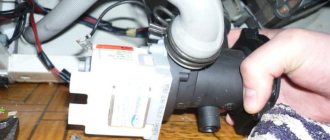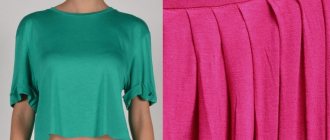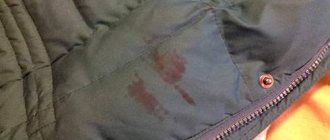Date: 10/24/2017
What to do if you don’t want to part with your favorite things, but they have already lost their original appearance and become faded? There is only one way out; they can be repainted. The question is especially often asked on forums: how to dye jeans in a washing machine? This procedure scares some housewives, but it is worth saying that there is nothing complicated about it. The main thing is to choose the right paint for dyeing clothes and follow all the recommendations indicated on the packaging with the coloring composition.
How to apply a pattern to jeans
The design can be applied using acrylic paints or regular markers! Choose any color and pattern you want. Acrylic should be applied with a sponge, not in a very thick layer. And the marker is just careful, trying not to go beyond the boundaries of the template.
Don't have time to deal with the problem? We will help! Repair of household appliances in Moscow and the region at the cheapest prices! tel. Read more about the technicians on the Techrevizor website here
Let the product dry for 24 hours, then machine wash it with powder. Now you know how to dye jeans in the washing machine and we hope that the result will please you!
See also:
- 7 best washing machines under 20,000 rubles according to customer reviews
- 8 best narrow washing machines according to customers
- 8 best BEKO washing machines according to customer reviews
- 10 best washing machines from Samsung
- 10 Best Top Loading Washing Machines
How to dye cotton and linen items with direct dyes?
Pour the powder into a container and add warm water dropwise to form a smooth paste. Add water to the paste in a ratio of 500 ml per 1 liter of water. Stir the mixture and strain through a cloth.
After this, dilute the finished solution with water at 40-50 degrees so that the diluted dye is 10-20 times larger in volume than the volume of the items. Dip things into the prepared solution and leave until boiling. After 20 minutes of low boiling, remove the items and pour in 2 liters of prepared saline solution (2 liters of salt per 2 liters of water).
If the finished color should be light, reduce the amount of salt by 2 times.
Lower the items and simmer for another 35 minutes. Remove the container from the heat and let it brew for another 35 minutes. Turn the garment over throughout the entire procedure to ensure even dyeing.
How to use natural dyes?
Selecting a retainer. Fixatives are necessary to ensure that the paint adheres better to the fibers. They differ and depend on the type of paint chosen:
- Natural paints made from berries are fixed with a fixative made from saline solution. To prepare it, you need to use 100-125 ml of salt and 8-9 glasses of cold water. Mix the salt thoroughly until completely dissolved.
- Dyes from onion peels and herbs are fixed with vinegar fixative. To prepare it, take 500 ml of white vinegar and 2 liters. cold water.
For chemical dyes, special fixatives are sold that are suitable for the type of material.
For the fixative to work, soak the item in it and leave for 60 minutes. After this, rinse the clothes under running cold water.
What and how is natural dye made from?
You can create a dye from natural material yourself. You need to collect plant material from which you will create your own shade. To make the shade rich and colorful, you should follow the collection rules:
- collect nuts in ripe form;
- berries, fruits and vegetables must ripen;
- If you are picking flowers, they should already be in bloom. It is better if, in terms of development, they are located closer to the final period of life;
- Collect stems and leaves in full growth.
Grind the collected herbarium into small pieces using a kitchen knife or a coarse grater. Grinding the vegetation allows the color pigments to be released. This way they end up in the water faster. Place the prepared parts of the plant in a large saucepan. The volume of the container should exceed the volume of vegetation by 2 times.
Pour in water to cover the cooked vegetables by half and set over high heat. Keep the pan over high heat until it boils. As soon as the mixture begins to bubble, turn the heat to low and let the mixture sit for about 1 hour. The mixture should simmer over low heat.
Cool the mixture to such a temperature that you can strain it. Use a sieve for these purposes. Pour the separated liquid back into the pan.
How to choose the right color?
You can make many different shades from natural materials, you just need to know which berries, herbs or vegetables give the color.
Here are the common colors that you can get from natural substances that are found in every housewife's kitchen or garden.
Red with a hint of brown - get it using pomegranate, beets, elderberries and dried hibiscus flowers.
Red with a hint of purple is obtained from blueberries, the herb basil and purple daylily flowers.
The brown color can be obtained from a decoction of oak bark, dandelion roots, walnut shells, acorns, and goldenrod sprouts. To obtain the same shade, tea leaves and coffee are used.
Purple with a blue tint is obtained from the squeeze of red cabbage, dogwood bark, cornflower petals, purple mulberries, blueberries, grapes and purple iris.
Pink is created from cherry, strawberry, raspberry juice and fir bark.
To obtain a bright orange natural dye, use onion peels, plantain or golden lichen seeds, and carrots.
The juicy yellow color is obtained from alfalfa seeds, bay leaves, St. John's wort flowers, calendula, dandelion, narcissus, turmeric and paprika.
The green tint is created from the squeeze of sorrel rhizomes, spinach leaves, and snapdragons. Flower heads of lilac and yarrow are used. Artichoke and yarrow plants are also used.
Shades from the color palette from gray to black can be obtained using blackberry juice in different concentrations, decoctions from the shells of walnuts, California ink.
How to care for painted items
All items require special care after dyeing. The following rules must be followed:
- Do not dry clothes in direct sunlight. This makes her burn out.
- You need to wash dyed items several times separately from the rest of your laundry.
- Each time after washing, during the last rinse, add a little vinegar to the water.
- To wash colored items, you must use a special powder, without various bleaches.
With the help of coloring, old things can be brought back to life, but only if you do everything correctly. It is worth considering that if there are various stains on the clothing, they will not be painted over evenly, and the color will still differ from the general shade.
How to paint with chemical dyes?
When painting with chemical dyes, the fixing agent is added to a container of boiling water. There are several types of fixatives that are suitable for certain fabrics:
- silk, cotton and other natural fabrics - 1/4 ml of salt per 6 liters of water;
- nylon and other synthetic threads - 1/4 ml of white vinegar per 6 liters of water.
To dye things, take a large pan so that things can be painted freely. On average, for 1 item, use a container with a volume of 7-8 liters.
Pour 5-6 liters of water and place over medium heat until it boils. As soon as the water begins to bubble, add fixative and dye. There are 2 forms of dyes on sale:
- liquid;
- granules.
When purchasing, pay attention to the label. It should contain instructions with the sequence of application. It also indicates how much paint needs to be added to the pan.
Powdered paint is most often poured completely into the pan. Liquid dye is added in measures (usually 6 liters - half a bottle). Stir the paint thoroughly so that there are no lumps left. After the dye has completely dissolved, lower the clothes.
Try to ensure that the item is completely immersed and evenly saturated with the coloring composition.
Once the water completely covers the clothes, let it boil. Once boiling, turn down the heat so that the water boils but does not splash. Simmer over low heat for 30-40 minutes, stirring occasionally. There is no need to cover the container with a lid.
Carefully pull out hot items with two forks and place them in a container where you can rinse under running water. Alternatively, transfer them to the bathtub or sink. During rinsing, dye leaks out of items, this is normal.
Rinse until they stop staining. Rinse with hot water, switching it to cold mode. When cold it is an excellent fixative. After dyeing with chemical dyes, hang dry the items.
Tumble drying is contraindicated. If you dry indoors, place a rag on the floor that you don’t mind throwing away. The fact is that drops can stain surfaces.
Will this affect the clothes I machine wash after dyeing?
After painting, be sure to wipe off any paint stains that form as a result of splashes and smudges that appear above the water level. If you are using reactive fiber dyes, you should wash your newly dyed items first in cold water, and then in water that is as hot as possible for the type of material. This will help extract more paint than normal. If you are using acid dye, you should wash the fabric only in cold temperatures, and then use hot water to wash the drum. After this, all excess dye should be removed, this will keep the machine clean and safe for the next wash.
Step-by-step painting technology
Well, let's get down to the most important thing. You have already washed the item, it is damp. Now you must dilute the coloring composition, based on the manufacturer's recommendations. Many manufacturers recommend adding a couple of tablespoons of table salt. If it says so, be sure to add it. If not, then this is not necessary, and they forgot to write.
If you do not need to mix with salt, then simply pour the paint into the drum. Run the long wash cycle at 40-60C. That's all! Then, at the end of the cycle, put it in a regular wash, using only cold water, adding powder and conditioner. This temperature regime will fix the coloring result.
After this, we take out the item and run the machine again. You can put some old rags, or you can put empty ones. This is necessary to collect the remaining paint from the drum and completely clean it. Also, we do not recommend washing white items immediately after this procedure, even after cleaning. God takes care of those who are taken care of, as they say...
As you can see, dyeing jeans in a washing machine is a simple thing.
Preparatory activities
Since the dye can stain the floor and furniture, it is necessary to cover the problem areas with film or paper, placing them in 2-3 layers. Prepare dish sponges or paper towels in advance. You will need them if you accidentally spill dye.
Any clothing must be washed before repainting. Paint only clean items, otherwise the paint will apply unevenly. To wash, dilute a soap solution of warm water and softening powder.
To get a richer shade, lighten your clothes using bleach. After washing, start dyeing immediately. The dye spreads evenly onto the damp fabric.
Alternative dyeing methods
If you still haven’t decided to dye it in the washing machine, you can try dyeing the product manually using one of the following methods.
The first method is to dye fabrics with natural dyes. Natural plants are used as such dyes. For example:
- Orange color is given by: carrots, plantain seeds, onion peels.
- Brown color is obtained from oak bark shavings, coffee, tea, nut shells, and dandelions.
- Berries give pink color: victoria, cherries, raspberries.
- Blue dye is found in cauliflower leaves, cornflower petals, blueberries, irises, and dark grapes.
- Red with a brownish tint will be obtained when stained with pomegranate juice, elderberry, beets, and hibiscus.
- The black color comes from ink nuts and blackberries.
- Green color is characteristic of sorrel roots, spinach leaves, lilac flowers, and yarrow.
- Yellow is obtained from bay leaves, calendula flowers, dandelions, St. John's wort, narcissus or turmeric.
Before you paint an item, you need to treat it with a fixative, which will help the paint adhere to the fabric. If the dye is berry, then use a salt solution as a fixative; take 125 grams of salt per 2 liters of water. If the dye is vegetable, then a solution of vinegar diluted in a ratio of 1:4 is used as a fixative, where 4 parts are water.
When the plant material is collected (leaves and berries must be ripe), it is cut into small pieces and placed in a large container. In this container you will dye clothes. Pour the dye with water and bring to a boil, then simmer the solution over low heat for about an hour.
Please pay attention! You need 2 times more water than dye.
After boiling, filter the water from the leaves or berries and place the product in it. We boil the clothes for an hour, turning them over periodically. The longer the item is in the water with the paint, the more intense the color will be. After the procedure, it is necessary to rinse the product well in cold water and air dry.
Article on the topic: Where not to place a washing machine
The second method involves the use of chemical dyes. To do this, pour water into a large container and boil. Next, add the fixing solution to the water. For cotton products, use salt at the rate of 1 cup per 3 liters of water, for synthetics, white vinegar, 1 cup per 3 liters of water.
Now add the dye, stir the water until it is completely dissolved. Next, put the clothes in the container, and, stirring for half an hour, simmer over low heat. All that remains is to rinse the product in plenty of water. You can rinse with hot water first, and then gradually reduce the water temperature. Rinsing in ice water will set the dye to the fabric.
Some tips for coloring
In conclusion, we offer some useful tips that will help you avoid common mistakes when dyeing clothes at home.
- Berry and vegetable dyes dye silk, wool and cotton better.
- It is not recommended to dye clothes made of polyester, acrylic, elastane, as well as clothes that are washed in cold water or only cleaned.
- Before the procedure, prepare napkins in case you accidentally spill paint. Wear gloves and an old robe.
- Strictly follow the instructions included with the dye.
- When dissolving paint, do not inhale it. Be sure to ventilate the room during and after work.
Good luck with your experiments with dyeing textiles in the washing machine!
You can buy paint to update the color of clothes at any hardware store. The item must be properly prepared for the procedure:
- wash and remove any stains;
- remove decorative fittings;
- weigh.
Painting is carried out in several steps:
- Dilute the paint in a container according to the instructions on the package.
- Strain the resulting solution and pour into a metal container.
- Place the desired item in the container in such a way that there are as few folds as possible and they do not “stick together” with each other. If necessary, add water so that it completely covers the product.
- Arm yourself with a wooden spatula and turn and “stir” the clothes from time to time so that the paint is well absorbed into the material.
Attention! The home dyeing method is not suitable for synthetic and polyester products. Such items can only be redyed by dry cleaning.
How to dye clothes in the washing machine
You can dye clothes in the washing machine in just 30 minutes. To do this you need:
- stir the paint according to the instructions on the package;
- pour the resulting solution into the compartment for powder or liquid detergent;
- wet the desired clothes in water and load them into the machine (wet fabric absorbs paint better);
- choose a washing program in which the water warms up to 95°C;
- wash things for at least half an hour;
- rinse the painted product in cold water (you can do this by hand or using a washing machine).
Article on the topic: How to wash a white T-shirt in the washing machine
After painting, there will be particles of dye in the drum of the washing machine that must be removed! To do this, just pour a little bleach into the powder compartment and run a “idle” wash using hot water. It is not necessary to load laundry into the drum
Secrets of dyeing denim blue
Each fabric differs in the structure and density of the fibers, and therefore has its own requirements for the dyeing process. The most unpretentious fabric is denim. It picks up the dye instantly, especially if you add an additional salt component to the dye solution (a glass of table salt will be enough for 1 kg of denim).
After the entire procedure, jeans will get dirty with water within 2-3 washes, so they need to be washed separately from other things.
Features of dyeing wool products
Wool fabric does not react well to the boiling process, so dyeing in this way will most likely ruin the item. It is better to stock up on paint that activates at temperatures below 100 ° C, and use a washing machine to be able to monitor the correct temperature conditions.
Special dyes are produced for woolen products - the so-called “vat dyes”. They are a little more difficult to use than regular ones, but they provide high-quality results.
How to dye cotton the desired color
Cotton items pick up paint much better if you first add edible salt to the dye solution. To obtain a light tone you will need 2 tbsp. l. per kilogram of clothing. The richer the color required, the more sodium chloride needs to be added. A beautiful black shade can be obtained by dissolving 4 tbsp in the dye. l. NaCl (if we are talking about one kilogram of laundry).
How to dye silk
Redying silk is a “delicate matter”, because this fabric belongs to the “noble” category.
In order for the silk product to evenly absorb the dye, before the color change procedure you need to rinse the item in a solution of ammonia (for 10 liters of water you will need only 50 g of the substance). Rinsing with ammonia will help remove the “repellent” antistatic agents that manufacturers impregnate silk clothes with from the fibers. Next, you need to follow the instructions indicated on the packaging of the selected dye.
Article on the topic: How to use the beko wmn 6358 se washing machine
The most crucial moment in painting is the choice of dye. It is advisable to take the item that needs dyeing with you to the store and consult a specialist about this.
What fabric can be dyed?
Before you start dyeing, try changing the shade on a piece of fabric of the same quality.
The most difficult things to dye are things made of nitron or lavsan. You can take such a desperate step if otherwise the item is simply impossible to wear.
Before painting, wash the clothes you just bought. Some manufacturers apply a special composition that protects against fading. To change the shade, you need to rinse things in a solution of a synthetic detergent.
- Mix 50 g of ammonia at a concentration of 25% in 10 liters of water.
- Soak and rinse the selected clothing.
- Rinse in clean water.
It is more difficult to tidy up clothes that have faded spots or dirt stains. Dirty areas can reappear after painting, so they need to be washed. The quality of dyeing used clothing depends on the required shade.
If you want to get a lighter tone than before, even out the tone further. If the overall color is darker than the original color, the faded spots will become invisible.
Fabrics made from natural fibers lend themselves best to dyeing. If you decide to redye something made of synthetic material, try to find special dyes that have a strong effect. There are certain requirements for the material that is being prepared for painting:
- A juicy, clean shade will turn out on white or any light-colored items.
- Cotton, muslin, silk or wool lend themselves better to dyeing with natural dyes.
- Cotton, wool, rayon, linen, ramie and nylon respond better to artificial dyes.
- For items consisting of 60% dyeable threads, it is better to use chemical dyes. Since the rest of the fibers cannot be dyed, the final color will be less saturated.
Items made of metalized threads, elastane and items with a “dry clean only” symbol on the tag cannot be painted.
How to dye pants by hand
For a procedure carried out without the participation of a washing machine, you will have to prepare a larger container - an enamel bucket, a basin, a large saucepan or similar large dishes. Large sizes are needed in order to be able to straighten the fabric as much as possible during dyeing, otherwise the jeans will acquire bright folds and stains.
For manual coloring, follow a simple sequence of actions:
- Dilute the paint in water. Color saturation is adjusted independently depending on the desired result.
- If necessary, add salt and soda (some manufacturers themselves indicate in the instructions on the packaging the importance of this addition, which allows you to fix the color).
- The dye is poured into a bowl, where another 5-8 liters of water are then added, and then the jeans themselves.
- Cook a pan or basin with jeans on the stove for an hour. Temperature – from 86 degrees. The contents of the container are stirred periodically.
- After an hour, the jeans are removed from the solution, then rinsed in warm and cool water alternately.
- The trousers can be soaked briefly (up to 20 minutes) in vinegar water to preserve the color.
How to paint?
You should not wait until the finished solution has cooled completely. Place the selected item and lower it into the pan. Turn on the heat and keep on medium heat. The gas should be turned off the moment the item reaches the desired shade.
There are a few things to consider:
The color looks brighter when wet than when dry. As soon as the clothes dry, their shade loses some brightness.
- On average, it is necessary to keep clothes on medium heat for 40 to 60 minutes.
- To get bright, rich colors, boil things in a saucepan for at least 8 hours. You can keep things for up to 12 hours.
- To ensure an even color, stir the clothes in the pan regularly.
- After painting, wash clothes in cool water and separately from the bulk of your items. You can dry it either in a dryer or in an open space.
Multiple restarts
You'll need a long cycle, longer than what's normally set on your washing machine, to give the dye plenty of time to react with the fabric. You must stay close to the machine and change the cycle before the machine begins to spin out the water at the end of the wash. If you still want to step away from the car, you should set a timer (for example, on your phone, but carry it with you) that will remind you to return before the end of the cycle. Otherwise, you may waste paint and auxiliary chemicals, allowing them to "float" into the water supply before you finish the procedure.











